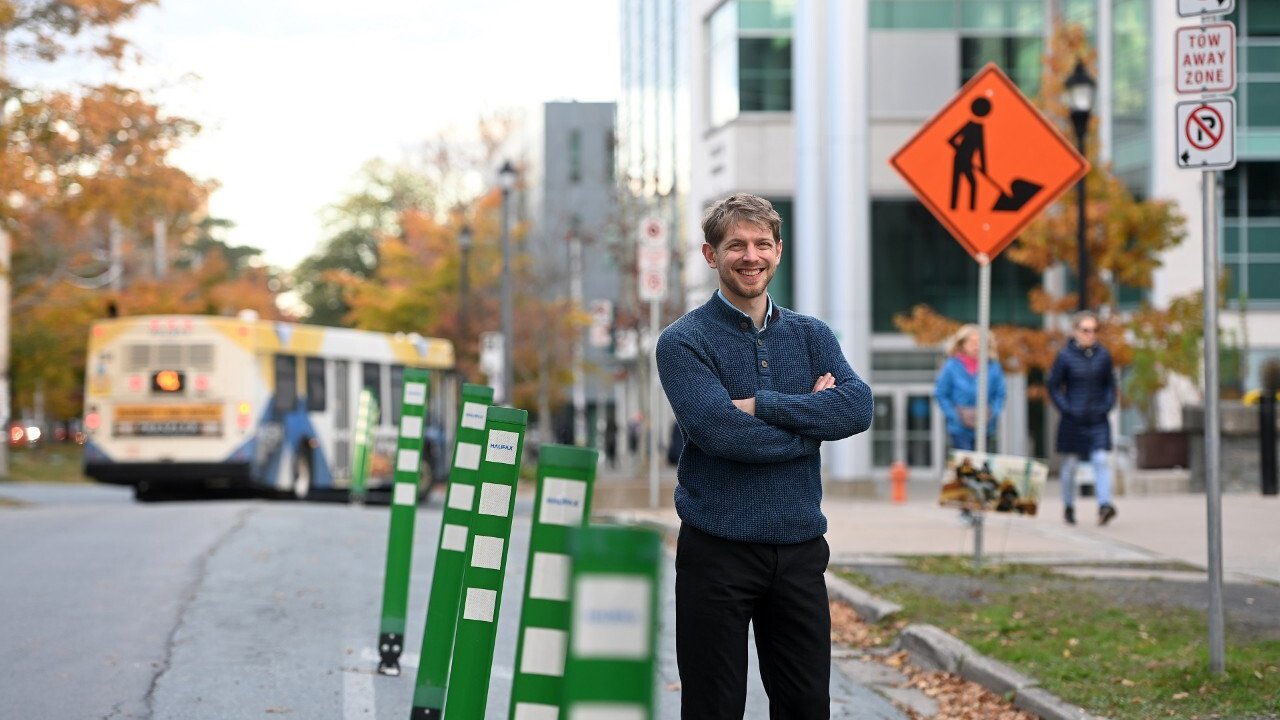In Conversation With An Expert: Tristan Cleveland of Happy Cities
Tristan Cleveland, an urban planner and research specialist for Happy Cities. (Source: Tristan Cleveland.)
For Tristan Cleveland, how our personal and collective well-being intersects with our built environment is no coincidence. He completed his PhD at Dalhousie University’s Healthy Populations Institute, where his research focused on operationalizing healthy communities across urban and suburban environments.
At Happy Cities, an urban planning, design, and research consulting firm, he uses this expertise to advise clients on how to design more complete and walkable communities.
Earlier this year, Cleveland joined Upzoned host Abby Kinney to discuss the value of building to the street and, more generally, the effect design has on the public realm. More recently, however, Cleveland was invited as an expert to provide his insights at the latest Crash Analysis Studio, which examined a crash in Brandon, Manitoba:
You were invited as an expert to provide your insights at our latest Crash Analysis Studio, focusing on a non-fatal crash in Brandon, Manitoba. What stood out to you when you first saw the site of the crash?
So what immediately stood out is something that I think, in general, urban planners and urban designers need to become more aware of when tackling suburban communities: the street is too wide. In theory, the lane widths are narrow and the curbside parking is intended to calm traffic, but in reality, most residents here have their own parking and so that lane is rarely full. As a result, the driving lanes appear much wider than they are.
If we can’t fully rely on street parking to slow down traffic and create that visual friction, it's important to put in physical interventions to make the street field narrower, especially at the intersections, to make sure people slow down. Something like a bump-out—and during the session, I shared strategies for designing bump-outs that don't force cyclists to merge with traffic—or even a small roundabout would prevent the potential for this sort of conflict.
What are some of the challenges facing our built environment today?
The political will for change is there, but the engineering profession has not caught up yet. Across so many communities (residential ones, especially), slowing traffic is a political win, but the design standards routinely stand in the way of what communities want.
As for why that is… So, my PhD was about efforts to redesign suburban communities to become walkable, pedestrian-friendly places. A big focus of that work was examining the institutional barriers to making those changes. The first thing to note is that the agencies that established all the street design standards in North America started explicitly and exclusively as highway agencies.
And they figured out all this stuff to make driving at high speeds safe and then took all of that and applied it to neighborhoods where we’d actually want to encourage slower speeds. There is a fundamental distinction between designing for high speed safety and designing for low speed safety. In fact, they require diametrically opposite designs, but the profession has never officially recognized that distinction. And as a consequence, you have standards that say that you need to balance these two things but, given their means and ends are the opposite, it’s like filling a hole while digging it.
What’s a good example of design standards being an impediment?
If we go back to the intersection from the Crash Analysis Studio: This street was chosen by the community for a bikeway. Instead of putting in separated or protected bike lanes, they put in sharrows. And what I'm seeing across Canada and the United States is that there's this desire to create safer, more walkable, more bikeable communities, and yet the way we approach it is, frankly, systematically half-assed.
And as a consequence, people die. It'd be like doctors knowing there is a cure for a disease, but choosing not to use it because they have a habit of doing something else. And it's unacceptable.
It needs to stop being the case that it is easier for cities to put in sharrows, or a single line of paint to demarcate a bike lane, as so often happens, because it is difficult for communities to install fully protected or separated bike lanes. As of now, many of our street design standards simply don’t allow the safest, best-practice design. In no other profession do we willingly implement designs that we know will kill people.
(Source: Tristan Cleveland.)
Conversely, what are you seeing today that’s giving you hope we’re going in the right direction?
Regarding official standards, we’re actually seeing change. In Canada, the Transportation Association of Canada has established two chapters on pedestrian-friendly and bicycle-friendly design that say a lot of the right things, so to speak, even if those chapters contradict the other, older chapters of the same standards book, which leaves the door open for applying the old standards.
Over in the U.S., The American Association of State Highway and Transportation Officials, AASHTO, began acknowledging context, meaning they recognize that different standards should apply in different kinds of places. That's promising, because it opens the door for making categorical distinctions, such as between pedestrian-friendly streets and high-speed roads, as Strong Towns has proposed. What this means is that the recommendations for an arterial that runs through downtown now differ from that of an arterial in an open rural expanse. While, frankly, I don’t think we should have anything that is functionally a major arterial downtown, context opens the door for categorical distinctions that will hopefully move us toward an understanding that you can either design for high speeds or slow speeds, but not both.
What’s actually happening on the ground level of many of our cities is also encouraging. Whether it’s Montreal or New York, engineers and planners are approaching street design with a totally different philosophy. In many cases, they’re reconstructing their own standards from scratch because the standards on a state, provincial, or national level don’t align with what they’re trying to do. These cities are offering great templates and inspiration, but I do hope that smaller cities and towns can make changes sooner, rather than later, too.
In order for any community across the country to start implementing slow design, or people-oriented design tomorrow, we need to update our design standards to make that the default, and not be treated as a dangerous exception.






On this episode of the Strong Towns Podcast, Chuck discusses safe streets advocacy with Amy Cohen, the co-founder and president of Families for Safe Streets.